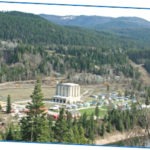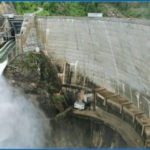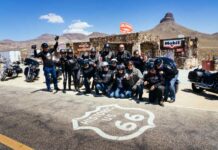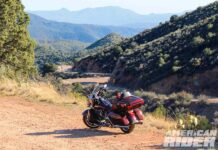Power trip
Views, wildlife and great roads
For my family, summers in the ’60s involved a crew of scrawny kids piled into the rear of a 1958 Ford Country Squire traveling from Seattle to Oklahoma and back again. Our route took in National Monuments, a few dusty ghost towns, and dams; lots of dams. I still recall sound echoing off concrete tunnels as we descended into the bowels of some dam, knowing a wall of water was just feet away. My dad worked for Seattle’s electric company, Seattle City Light, so it was pride and curiosity that drove these detours off the highway to experience those damn dam tours. It would make him smile that I’m now touting the very thing that stood in the way of a longer splash in the motel pools of my youth.
Juice for Seattle
Boundary Dam came online in 1967 and sits at the border of British Columbia, Canada and Washington State, making hydroelectric power from the Pend Oreille River. Getting there is well worth the trip on its own merits, but the sheer size of a 740-foot long, 340-foot tall dam carved into limestone is a spectacle anyone can enjoy courtesy of guided tours offered Memorial to Labor Day. Electrical current from Boundary is transmitted up and over the craggy limestone cliffs, and then through transmission lines for the 350 miles to Seattle. It arrives in a hot second. Each spring, operators release water onto its spillways where the water, moving at 60 mph, provides a spectacular cascade as it falls. The volume originates from spring thaw as far away as Montana, pausing at several dams as it meanders west.
The north-flowing Pend Oreille River is the second largest river in the state, augmenting the Columbia by a third when they join in Stevens County. Between Albeni Falls Dam in Idaho, and Box Canyon Dam, viewable from Highway 31, there is a 55-mile stretch of near-still waters with vacation cabins, humble dwellings and architectural masterpieces overlooking this living waterway. The 20 miles between Box Canyon Dam north to Boundary are pristine river miles, encroached upon by few homes along that route.
Pend Oreille County, with less than 13,000 residents, does not yet have—nor frankly does she need—a traffic light, but the county is perhaps best known among wildlife biologists as “the zoo” due to the abundance here. Native whitetail deer, Rocky Mountain elk, the endangered woodland caribou, protected grey wolf and grizzly bear, mountain goat, cougar, lynx, moose, black bear and an astounding wealth of migratory birds live or travel through this region. The top reasons cited for visitation in a 2005 Dean Runyan study remain: 1) scenic beauty, and 2) wildlife viewing. Trust me, this landscape delivers. The climate is less arid than most of Eastern Washington, there are no poisonous snakes and, thanks to the wealth of hydroelectric dams, residents and businesses enjoy the lowest-priced electricity in the nation at 3.85 cents per kilowatt-hour.
Bird watchers are drawn to the April migration of tundra swan and the annual Swan Festival, but canoeing and kayaking, bass fishing, hiking, camping, big game or turkey hunting, wildlife viewing, photography, mushroom foraging, and nature loving motorcyclists all consider this place the ticket. And with so few deputies, you’ll likely be able to avoid a roadside encounter for an overenthusiastic throttle hand.
Boundary Tours offer interpretive displays, a scale model of the site, and the Vista House observation area overlooking it all. Inside the larger-than-life turbine powerhouse it’s very James Bond-esque. But the no-nonsense efficiency from Boundary employees would likely not entertain even a Connery cardboard cutout. They’re gracious hosts, but the humor in this serious operation is pretty lean. That’s unless you count a highly professional dam supervisor sporting a mullet. That guy must have a sense of humor.
Kevin Costner featured Boundary Dam in The Postman (1997) erecting a Pueblo-style city on the dam’s face. Nearby Metaline Falls was dubbed Bridge City for the film and it was closed to visitors several days per week during filming. Still, locals enjoyed Costner and and his co-star, musician Tom Petty, who played the mayor of Bridge City. The film depicted life after an apocalypse, transforming the quaint city into shades of a bleak gray. Metaline Falls is familiar with gray—from 1914–1990, when cement manufacturing was the main employer, residents were provided with chemicals to clean the cement dust off their rooftops and vehicles. The silos still stand, shadowy remnants of the past.
Directions: From Spokane take US 2 North to Pend Oreille County; Highway 211 cut-off to Usk; north on Highway 20 to Tiger, and there continue north on Highway 31 until the town of Metaline. Grab a huckleberry cone at Granny’s, then at the northern edge of Metaline turn left (west) uphill onto Boundary Road and ride about eleven miles to a Y. Keep right for Boundary Tours, or left to see a limestone cave used by bootlegger Ed Gardner in 1909 to hide spirits among the stalagmites and stalactites. Gardner Caves is wonderful on a hot day, with average temps around 40 degrees, so wear your leathers. Tours at 10, noon, 2 and 4 p.m.
Boundary Dam hours are Thursday through Monday from 10:30 a.m. and you’ll need photo ID. Tours are free, and frequent, but depending on national security threats, access may be restricted. So phone ahead (509.446.3083) or look online for more information courtesy of the Pend Oreille River Tourism Alliance, www.porta-us.com.























